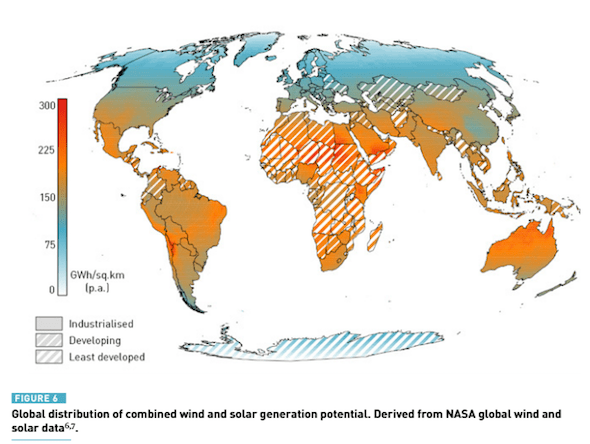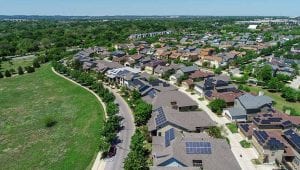Australia has the opportunity to become a renewable energy superpower – giving it a global economic advantage much greater than that ever gained from fossil fuels – a new report has suggested, but only if it seizes three key areas of opportunity, based heavily on innovation; and only if it acts quickly and doesn’t miss the wave.
The report, published on Monday by Beyond Zero Emissions, notes that Australia – despite having one of the best renewable energy resources in the world – is currently on the back foot in the global energy stakes.
Its “fossil fuel advantage” is fast disappearing , and it has an outdated and gold-plated electricity network that has acted as a ball and chain to progress.

But it also suggests that Australia could turn this position around, by building an industry that supplies the renewable and energy efficiency market; by assisting the migration of energy intensive industries to renewables; and by harnessing the trade of renewable energy commodities.
The global shift to renewable energy – while largely a democratising force – will still bring advantages to some nations, the report says.
“The value associated with renewable energy is largely accounted for by the harvesting equipment, with very little ongoing costs and zero fuel costs. This is completely different to fossil energy where the majority of the value is in the ongoing consumption of fuel.
“As a result, the opportunity to capitalise on supplying renewable energy and efficiency equipment will be confined to the period of the transition; then it will recede.
“This opportunity will be based on innovation rather than natural resources. Considering that energy harvesting equipment is commonly available to all nations, advantages will accrue to nations or regions with higher quality renewable energy resources and a greater harvesting territory in relation to their domestic energy needs (Figure 6).

“In essence, these nations will require less investment for equivalent energy output, lowering their energy costs. …the cost of power per unit of installed capacity can more than halve across the typical range of wind or solar conditions,” the report says. “This is the new energy advantage.”
According to the report, there are three main opportunities for “superpowers” in the transition to renewable energy.
“First, demand for renewable energy and efficiency equipment will surge during the transition and then recede.
“Second, after the transition, energy intensive industries will relocate in search of low-cost energy. Third, renewable energy commodities for export will be produced in countries with low-cost renewable energy.”
BZE says the sources of value in the energy system will change in the transition from fossil energy to renewable energy, developing in different phases (see figure 8 below).

Having now reached the tipping point, the report notes that the majority of world energy investment over the next two decades is expected to flow to renewable energy and efficiency solutions – even under ‘business as usual’ conditions.
According to BZE, the global market for renewable energy and efficiency solutions is expected to grow from an estimated $US390 billion in 2013, to $US2.3 trillion by 2035 in order to limit global warming to 2°C.
In all, says the report, $US28 trillion is expected to be invested in renewable energy and efficiency throughout the period.
“The nature of renewable energy solutions is upfront equipment costs replacing the ongoing high fuel costs of fossil energy. This means that this opportunity will be at its strongest during the energy transition phase and recede into the renewable energy era.
As for energy intensive industries, the report says the economics of renewable energy will trigger a migration of this secor, in search of lower production costs for a competitive edge.
“Australia can attract these businesses with its abundant, low-cost energy as well as complementary industries established during the former glory years of energy intensive production in this country.”
Tradeable renewable energy commodities — such as biofuel, hydrogen or transmitted electricity — will be additional energy intensive industries of the renewable energy era, the report says.
And for Australia, “abundant, low-cost renewable energy, land availability, and proximity to the emerging Asian region,” make it a perfect fit.
“Managed well, the transition to renewable energy will restore and enhance former strengths, this time built on sustainable foundations,” the report says.










